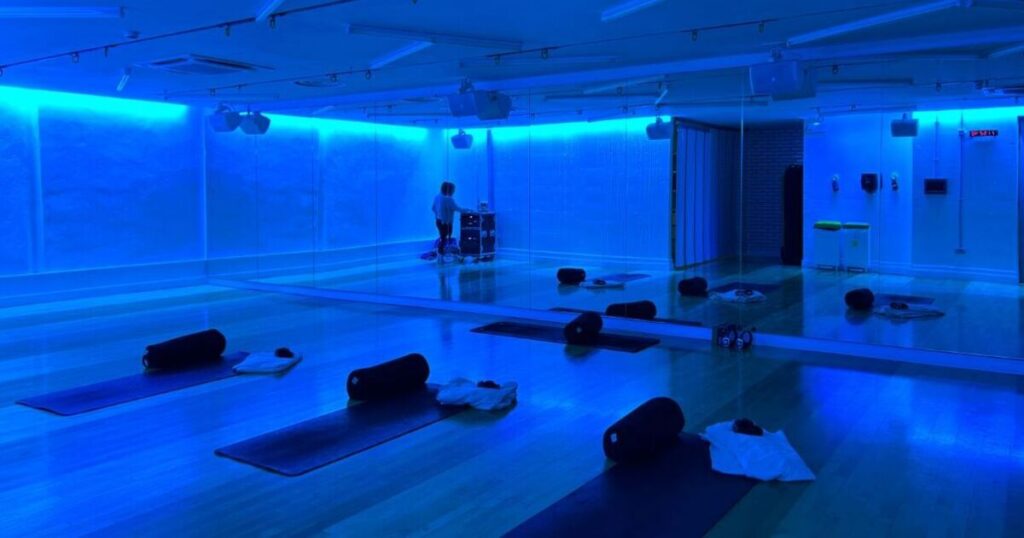

Can a ‘binaural beats’ relaxation class help me feel calm? (Image: Tahira Ali)
I’m lying on a hard dance floor with just a thin mat and cushion under my knees for comfort, my back cannot get comfortable and the hair stuck in my headphones itches.
I’m in a relaxation class at London fitness chain, Gymbox, in which participants listen to binaural beats, a new neuroscience-approved brand of electronic music that promises to boost calm, reduce stress and improve sleep.
Unsurprisingly videos featuring binaural beats are also a hit with Gen Z, going viral on TikTok, with up to five million views.
“Binaural beats are an auditory phenomenon that occurs when two tones of slightly different frequencies are played in each ear,” says neurologist Dr Faye Begeti.
“When each ear hears tones of different frequencies, the brain perceives the difference between the two frequencies as a third sound.
Don’t miss… Charlotte Church’s ‘Dreaming’ retreat left me with nightmares – this is why

Neuroscientists recommend listening to binaural beats to help overcome anxiety (Image: Tahira Ali)
“For example, if a 300Hz tone is played in one ear and a 310Hz tone in the other, the brain perceives a 10Hz beat.”
There’s a reason the music in the class isn’t being piped through the speakers too. “This phenomenon relies on listening through headphones to deliver different frequencies in each ear. Without headphones, the ‘beat’ disappears,” says Dr Begeti.
The music is said to reduce mental stimulation and lead your brain towards a deeply relaxed state. It promises to make falling asleep easier and induce a deeper sleep.
Will I experience these effects? Initially, I’m sceptical. I’m aware of the two others in the class either side of me, slumping on the floor, looking as relaxed as rice sacks, and I cannot help wonder, ‘why can’t I let go?’
Our instructor Phoebe guides us through each step of relaxation as we travel from each frequency. The music is best described as a collection of sounds with a lo-fi edge. It feels like a wave vibrating, gently travelling through my ears and down my sides.
There’s something hypnotic about it. The discomfort I first felt is falling away and my racing mind begins to slow down. I start to feel lifted.

Binaural Beats is music made of two different frequencies (Image: Tahira Ali)
We’re told to observe our mind’s behaviour and to “make no judgments”, however Phoebe’s questions catch me off guard: “How has your mind behaved? Has it been too much in the past? Or the future?”
I’ve just moved to London and I’m finding city life overwhelming. I focus on this moment of peace, wondering how Londoners manage their never ending schedules.
Phoebe asks whether our minds have felt focused, critical, or productive this week. She tells us to rub our hands together to create heat and then place them on our closed eyes, our face and around the ears. It feels surprisingly good: warm and nourishing – like kinetic energy being spread through my body.
With the blue light behind my eyelids and sounds pulsing through my ears, I imagine myself submerged into a sea of calm.
Phoebe begins a meditation, asking us to think of a memory that we’re grateful for. An image of my nana appears in my mind. She passed just before the first lockdown of Covid, and I think of her most days. I think of my parents and friends too, and finally my body finally settles.
This is all part of the auditory journey designed to help our brain focus, boost imagination, memory and sleep. The effect can be surprisingly powerful. “I’ve had some people that will be completely asleep for an hour,” says Phoebe. “But it depends on what we need in that moment – your body will go deeper into relaxation if it truly needs it.”
After 45 minutes, the class ends and Phoebe gently suggests we remove our headphones and sit up whenever we feel ready. As I try to rise up from the floor my body feels three times heavier than when I walked in the room.
My thoughts, while not silenced completely, are far quieter and I have a feeling of gratitude that wasn’t with me before. As I exit the gym, I note how my feet feel grounded, I feel more awake and the buzzing tiredness of a morning headache has faded.
I feel more present and positive: I was more generous when asked to give to charity, I helped two groups of tourists navigate the Tube, I bought casual gifts for my family.
The most surprising result was that I’ve had insomnia for nearly three years now but that night, I had a solid eight hours of sleep.
For more information about Gymbox’s Binaural Beats class, visit gymbox.com

I’m lying on a hard dance floor with just a thin mat and cushion under my knees for comfort, my back (Image: Tahira Ali)
Beats for the brain
Neurologist Dr Faye Begeti explains the science behind the TikTok wellness trend
What effect can binaural beats have on the brain?
Binaural beats are believed to influence brain waves through a process known as brainwave entrainment, where the brain’s natural neural oscillations synchronize with the frequency of the perceived binaural beat.
This occurs when the brain’s natural neural oscillations synchronize with the frequency of the perceived binaural beat. Low-frequency binaural beats, such as those in the delta (0.5–4 Hz) and theta (4–8 Hz) ranges, are associated with relaxation, meditation, and sleep, while higher frequencies like alpha (8–14 Hz) and beta (14–30 Hz) are linked to focus, alertness, and cognitive engagement.
Is there evidence that binaural beats work?
Evidence suggests binaural beats may offer various benefits, though individual responses vary and more research is needed. So far, benefits shown in studies include improvements in mood, stress reduction, and better sleep. One study even found that incorporating binaural beats during anaesthesia in children reduced the amount of anaesthetic required.
Can different combinations of binaural beats have different effects on the brain?
Different combinations of binaural beats can produce varied effects depending on their frequency. For example, delta and theta waves promote relaxation and sleep, while alpha and beta waves enhance focus and alertness. Some studies suggest combining binaural beats with ASMR – soft, rustling sounds that trigger tingling sensations in the brain and spine – may enhance relaxation and stress reduction.
Do people with neurodivergence – for instance ADHD – feel the effects of binaural beats more than ‘neurotypical’ brains?
This is an area of active exploration. Some researchers hypothesize that individuals with neurodivergence, such as ADHD, may respond more positively to binaural beats targeting focus (beta waves) or relaxation (theta waves) due to differences in brain activity. More research is needed to validate these claims scientifically, as individual responses can vary significantly.
Are there any dangers in listening to binaural beats?
Binaural beats are generally safe, but individual responses vary – while many find them relaxing, others may not experience the same feeling and find them ineffective. As a neurologist, I always advise my patients to keep headphone volume low, as prolonged exposure to sound levels above 85 decibels can lead to hearing loss, which is a known risk factor for developing memory issues later in life.
Listen to Dr Begeti’s Spotify playlist, Professor Green’s Restful Rhythms playlist, created in partnership with Holiday Inn Express.
 Latest World Breaking News Online News Portal
Latest World Breaking News Online News Portal






